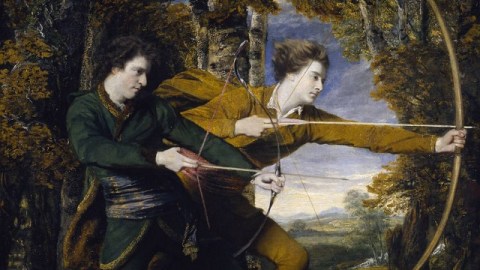Should Museums Stop Teaching?

When the Tate Britain recently revealed the latest rehanging of their astounding collection of British art, many long unseen works found a new place in the galleries, but one long-standing feature was not to be found—explanatory wall text. The Guardian’s Jonathan Jones hails this rehanging as “a radical rethink at Tate Britain that also sees more paintings on its walls, sculptures on its floors and history in its bloodstream than ever before.” Is this rethinking of the role of the explanatory wall text the first step in a rethinking of the role of a museum itself? Would it be a good or a bad thing if museums no longer supplement our direct, naked experience of the art? Should museums stop teaching?
The BP Walk through British Art, inseparably linking the thing itself and corporate sponsorship like an American sports stadium (see the Mets and Citi Field for a worst-case scenario), offers the viewer a “walk through time” as you move from 1545 to the present day through art. “There are no designated themes or movements,” the website breathlessly offers, “instead, you can see a range of art made at any one moment in an open conversational manner.” It’s fascinating to see the lack of a curatorial voice characterized as an “open conversational manner,” as if to imply that the experts were always in the way before.
With this new format, Jones gushes, gone are the previous museum prejudices (pro-thematic galleries, anti-chronological galleries) and “sometimes minuscule representation of its enormous collection of British art,” thus bringing in “a return to history, and even patriotism.” You can almost hear “Rule, Britannia!” playing in the background when Jones writes, “A Walk Through British Art feels like a walk through Britain itself. Not all of it is beautiful, not all of it is glamorous, but it’s our country all right.” (Note how quickly Jones dispatches BP from the title in the name of God, Queen, and country.) The Tate Britain “promises” that this latest rehanging will last longer than previous arrangements of the collection. Is it possible that the tradition of periodic rearranging will go out the window, too, and this “Walk” become a last, perhaps permanent step in the transformation of the museum?
People will always hold differing opinions on explanatory wall text in museums. Dr. Albert C. Barnes’ Barnes Foundation famously banned wall text in the name of allowing viewers to have an unobstructed, direct, unbiased encounter with the art before them. Even in its new home, Barnes’ Foundation honors his wish for text-free walls. Others, including myself, contend that, especially in an America where arts education is dwindling to practically nothing, wall text providing extra information in a convenient form might be the only arts education most people receive. Considering that the average museumgoer barely registers each work before racing on to the next, wall text might be the only “speed bump” that compels the uninitiated into slowing down for greater appreciation and understanding.
And then there is the peril of exactly what “understanding” that wall text conveys. If history is written by the winners, then art history is written for the winners of whatever narrative holds sway at the time. For example, the once anti-establishment Impressionists reign now as the quintessential establishment art movement—family and wall calendar friendly—so the wall text of today will reflect that reality. A circa 1870s wall plaque beside a Claude Monet, however, would have told a much different story. In Jones’ piece, Sir Joshua Reynolds emerges as “an unexpected star” of the new arrangement. “Nowadays he is often thought of as a bit tedious compared with his brilliant contemporary Joseph Wright of Derby, say,” Jones writes of Reynolds, but in the new setting, Reynolds wins the rematch thanks to works such as the underappreciated Colonel Acland and Lord Sydney: The Archers (from 1769; detail shown above). As the preeminent aesthetic theorist of 18th century British art and the first president of the Royal Academy, Reynolds overshadowed many other artists during his lifetime, including William Blake, the visionary outsider who hated Reynolds and his kind with a burning passion.
Jones writes that the Reynolds revelation is “the kind of surprise that makes A Walk Through British Art a total delight.” I wonder, however, if someone without Jones’ knowledge of the art world would reach the same conclusion. Perhaps someone without the same background at Jones would vote for Derby, Blake, or someone else lurking nearby in the chronological jungle. I also find it a little disturbing that Jones’ choice recrowns the same champion contemporaries did. Have the intervening centuries meant nothing? Or is Jones reaching a pure state of art appreciation beyond space and time that I’m not crediting? Of course, Reynolds painted beautifully and belongs in the conversation. I just don’t think he should get to end the conversation, again.
Ultimately, the question of whether museums should teach is really a question of whether those who experience art can or should rely solely on their own senses and impressions. I recently had a classical music revelation and “discovered” Haydn for the first time. I’d heard Haydn’s music countless times, bought the major works on CD, and read the standard arguments for his greatness, but he always fell short, usually for not being Mozart or Beethoven. After watching Charles Hazlewood’s BBC Birth of British Music documentary on Haydn, however, I finally learned to love Haydn for his Haydn-ness and to get beyond my own prejudices about that dangerous terms “greatness.” Sure, museums can educate us into prejudices, but they can also educate us out of them. I applaud the Tate Britain for trusting its patrons to judge for themselves, but I’ll also applaud them when they trust those same patrons to think critically even in the face of “expert” opinion.
[Image:Sir Joshua Reynolds. Colonel Acland and Lord Sydney: The Archers (detail), 1769.]





